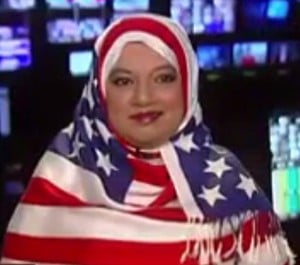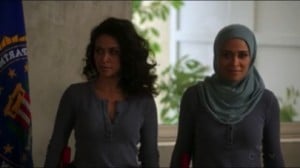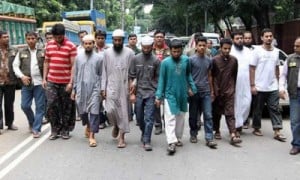On September 16, 2014, basketball’s international governing body, FIBA, announced it would be allowing headcoverings during competitive play for a trial period. It stopped short, however, of permanently lifting its ban on hijabs, turbans and yarmulkes worn by basketball players. Stories of players being rejected from tournaments and forced to forfeit because of their headcoverings have been reported for the last few years.
A development that could potentially include thousands of players is great news.
Sort of.
First of all, the decision itself, and any remaining requirements that players must adhere to, is not clear. Second, this issue was minimally covered in the media because it isn’t a hot story. As someone who has been through a similar process and faced exclusion from a sport, I find both the lack of clarity from FIBA and the lack of coverage by media equally frustrating.
![Basketball player Indira Kaljo. [Source].](https://wp-media.patheos.com/blogs/sites/92/2014/09/basketball3-300x207.jpg)
However, the results of a FIBA meeting in Istanbul were not exactly what prominent Muslimah athletes such as Indira Kaljo and Bilquis Abdul-Qadir were hoping for. “I am elated” Kaljo told me, “But what are the next steps?”
She has been trying to seek clarification about whether she can now play professionally, but the obstacles, such as the club having to petition the National Basketball Federation for a change of uniform, seem unnecessary and arduous. “We have been tirelessly trying to contact one person….they will not give us one point of contact for clarification,” says Kaljo.
The recent decision to temporarily allow headbands of more than 5 cm is complicated. It allows players to wear hijabs or turbans, but they must apply for eligibility for their headcoverings to be part of their uniform. This formal application is submitted before each match to the governing body of the national basketball program of their club or team. The federation would notify the referee association and the player would be allowed to compete. But even the details of how this would work are not specified by FIBA.
The problem is that this is tremendous paperwork and might be considered a liability for any professional team. If the FIBA ban were lifted altogether, then the players could, well, simply PLAY.
![Egypt’s national women’s basketball team. [Source].](https://wp-media.patheos.com/blogs/sites/92/2014/09/basketball1-300x200.jpg)
I’ve become very familiar with the case of the soccer world, governed by FIFA, finally allowing hijabs, through an approach that differed with that of FIBA. During a trial period that was announced by IFAB (the governing body of FIFA) in July 2012, women were allowed to wear hijab and a specific prototype was being tested by a medical safety team. Less than two years later, the ban was formally lifted.
Pressure for FIFA to lift the ban came from an executive committee member, Prince Ali bin al-Hussein of Jordan, who was spearheading the campaign. FIBA does not have a similar representative on its committee pushing for change. Without considerable media attention and pressure on FIBA, the fate of basketballers is still in limbo.
Another difference between this case and that of FIFA is the media attention.
If there were any reports on the coverage of this issue in mainstream media, they were presented by men, who may be in favour of lifting the ban, but there were no perspectives from actual Muslimah players themselves. There were smatterings from major sports outlets such as ESPN and a heavily recycled piece by Doug Feinberg of the The Associated Press.
I spoke with SLAM magazine contributor and basketball expert Habeeba Husain, who wrote a fantastic piece (that ought to have been shared widely) about this issue. She explained to me that, from her perspective: “Hijab isn’t the barrier. A lot more misunderstanding took place. FIBA was the barrier and so was their decision making process.”
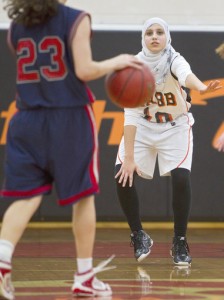
I had approached and pitched this story to different sports editors and did not even get a reply. Then again, why on earth would this story appeal to sports editors? A story about Muslim athletes isn’t as click-worthy without catchwords such as “struggle” or “fight” against stereotypical systems that allude to the Muslimah athlete’s “freedom” from family, religion, or culture. A story about how hijab does not oppress or get in the way of an athlete’s ability is also considered newsworthy.
But the boring yet very relevant stories of bureaucracy and politics that athletes must endure are not as exciting. They don’t provide warm fuzzies or speak of the struggles and pain of an athlete’s journey. That doesn’t diminish their importance in reality. Sport media has an obligation to present these developments as they pertain to sports.
The most widely circulated recent story about a Muslimah athlete was the tale of a team of non-Muslim young women coming to the rescue of their teammate Samah, who was banned from playing soccer because of her hijab. Before a game, her teammates decided to wear hijab and took a picture, which was lauded as incredible solidarity. This feature created a fresh “feel-good-about-hijab-in-sport” legend, but as I wrote about in a previous MMW piece, the focus of the media was not on Samah or her struggles, but on the gesture of the team. The deeper story was completely ignored.
The deeper story of this latest FIBA ruling may not appeal to major sports outlets, and their editors may shrug it off as uninteresting. Particularly when there are more important stories to cover, like how prominent female sportswomen get naked for photoshoots, or more recently how famous athlete’s computer systems are being hacked and their nude pictures leaked.
This gets significantly more attention.
There are reports of women’s basketball leagues, tournaments and varsity competitions teams with Muslim women participating – not just from the US but from all over the world. For sports media journalists to discount all of these players by not publishing stories on their formal access to the sport is irresponsible. The potential that basketball programs may now be open to athletes who wear hijab is great story. To recognize that clarity from FIBA is critical in order for these women to play is and participate is a good story. It is a good for the game and it is newsworthy.
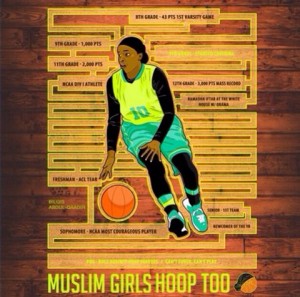
When I spoke with Habeeba Husain of SLAM, she suggested that the lack of press attention on this topic actually is indicative of how few people of colour and Muslims are represented in sports media, and of who decides what story gets covered. No pun intended.
When sports journalists actually do cover real stories of Muslimahs, as banal as they may seem, there seems to be a sense that we should be grateful. Haseeba has seen this trend from Muslimah athletes who “thank” journalists for covering their stories.
“You want to thank them,” says Habeeba, “but you shouldn’t have to. It’s their job.”



